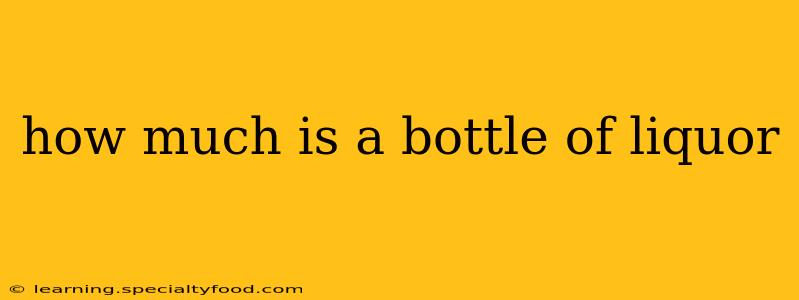How Much is a Bottle of Liquor? A Comprehensive Guide to Pricing
The price of a bottle of liquor varies wildly, depending on several key factors. There's no single answer to "how much is a bottle of liquor?", but understanding these factors will help you budget and navigate the world of spirits.
What Factors Determine the Price of Liquor?
Several elements contribute to the final cost of a bottle of liquor you see on the shelf. These include:
-
Brand Recognition: Established, well-known brands often command higher prices due to their reputation, marketing, and perceived quality. Think premium brands like Johnnie Walker Blue Label or Hennessy Paradis compared to their more affordable counterparts.
-
Type of Liquor: Different spirits inherently have different production costs. For example, high-end single malt Scotch whiskies undergo extensive aging and meticulous processes, driving up their price compared to a readily available vodka. Rare tequilas or aged rums also fall into this higher price bracket.
-
Age and Aging Process: The aging process significantly impacts the price, particularly with whiskeys, bourbons, and tequilas. Longer aging periods generally lead to richer flavors and a higher price tag. The type of barrel used also plays a crucial role in both flavor and cost.
-
Ingredients and Production Methods: The quality and sourcing of ingredients (grains, fruits, etc.) and the complexity of the production process directly affect the price. Hand-crafted, small-batch spirits often carry premium prices.
-
Bottle and Packaging: The design and materials used for the bottle and packaging add to the overall cost. Luxurious bottles with intricate designs or special presentation cases contribute to the higher price points of some premium liquors.
-
Location and Taxes: State and local taxes, as well as the location of purchase (e.g., airport duty-free vs. a local liquor store), can influence the final price considerably. Prices in high-rent areas tend to be higher than those in more affordable locations.
How Much Can I Expect to Pay?
The price range is vast, spanning from under $10 for a basic bottle of vodka or rum to several thousand dollars for limited-edition, ultra-premium spirits. Here’s a very general guide:
- Budget-Friendly: $10-$25 (Many vodkas, rums, gins, and less expensive whiskeys fall into this range).
- Mid-Range: $25-$75 (Many popular brands and some higher-quality spirits).
- Premium: $75-$200+ (Higher-quality spirits, aged liquors, and well-known brands).
- Luxury: $200+ (Ultra-premium spirits, limited-edition bottles, and extremely rare items).
What is the average price of a bottle of liquor?
There is no single "average" price. The average price depends heavily on the factors listed above and varies greatly by region and retailer. It is more useful to consider the price ranges described above to establish a reasonable expectation.
Where can I find the cheapest liquor?
Liquor prices vary significantly by location. Discount liquor stores, warehouse clubs, and online retailers (where permitted) may offer lower prices than upscale liquor stores. Remember to compare prices before you purchase. Check for sales and promotions, as these can greatly impact the final price.
What factors affect the price difference between similar liquors?
The most significant factors are brand reputation, aging process, and production methods. Two bourbons might use similar ingredients but differ widely in price due to the length of aging or the brand's prestige.
By understanding these factors, you can make informed decisions about your liquor purchases and find the perfect bottle to suit your taste and budget. Remember to always drink responsibly.
